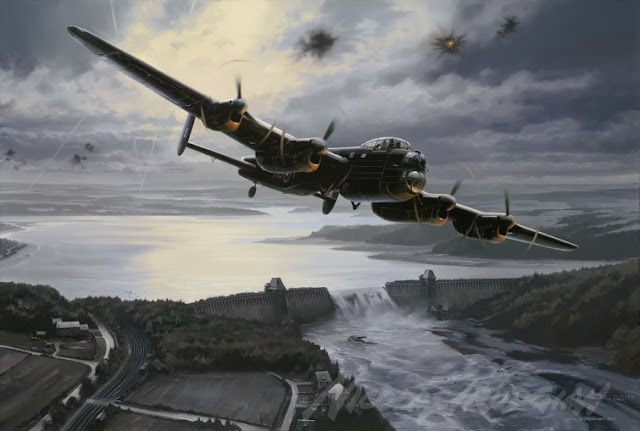Remembering the Dambusters
75 years ago today, on 16th May 1943, nineteen specially modified Lancaster Bombers of RAF 617 squadron, led by Wing Commander Guy Gibson, took off to attack the Ruhr dams in Germany.
The attack which followed on the night of 16th/17th May, codenamed Operation Chastise, using purpose-built "bouncing bombs" developed by Barnes Wallis to breach the Möhne and Edersee Dams, caused catastrophic flooding of the Ruhr valley and seriously disrupted military production for the Nazi war effort.
James Holland's recent book, Dam Busters: The Race to Smash the Dams, argues that
"it is time to put the record straight."
He insists that the damage was "absolutely enormous" and it was "an extraordinary achievement."
Every bridge for 30 miles below the breached Mohne dam was destroyed, and buildings were damaged 40 miles away. Twelve war production factories were destroyed, and around 100 more were damaged. Thousands of acres of farmland were ruined. Two hydroelectric power stations were destroyed and several more damaged. Factories and mines were also damaged and destroyed.
Germans instantly referred to it after the raid as the "Mohne catastrophe". Even the cool Speer admitted that it was "a disaster for us for a number of months". German sources attribute a 400,000-tonne drop in coal production in May 1943 to the damage caused.
The fact that a titanic effort was made to repair this damage shows how high a priority the dams were, and it meant resources were shifted from elsewhere. Nowhere was this costlier to the Third Reich than on the beaches of Normandy.
Hitler had ordered the construction of a massive network of defences against an Allied invasion. Now thousands of workers who should have been toiling in France were redirected to the Ruhr to repair the dams. A year later allied troops would have faced far more significant defences had it not been for the Dambusters raid.
No raid mounted by so few aircraft had ever caused such extensive material damage. It did not bring German war production to a permanent halt, but nobody had expected it to.
Historian Dan Snow argues here that
"The most important impact of the Dambusters raid may indeed have been in convincing people on both sides that the Allies were winning, and that, often, is how wars are won and lost."
Eight of 617 squadron's aircraft were lost, 53 of the aircrew were killed and three taken prisoner. Thirty-four of the survivors were decorated, with Gibson awarded the Victoria Cross.
The attack which followed on the night of 16th/17th May, codenamed Operation Chastise, using purpose-built "bouncing bombs" developed by Barnes Wallis to breach the Möhne and Edersee Dams, caused catastrophic flooding of the Ruhr valley and seriously disrupted military production for the Nazi war effort.
RAF 617 squadron has been known ever since as "The Dambusters."
James Holland's recent book, Dam Busters: The Race to Smash the Dams, argues that
"it is time to put the record straight."
He insists that the damage was "absolutely enormous" and it was "an extraordinary achievement."
Every bridge for 30 miles below the breached Mohne dam was destroyed, and buildings were damaged 40 miles away. Twelve war production factories were destroyed, and around 100 more were damaged. Thousands of acres of farmland were ruined. Two hydroelectric power stations were destroyed and several more damaged. Factories and mines were also damaged and destroyed.
Germans instantly referred to it after the raid as the "Mohne catastrophe". Even the cool Speer admitted that it was "a disaster for us for a number of months". German sources attribute a 400,000-tonne drop in coal production in May 1943 to the damage caused.
The fact that a titanic effort was made to repair this damage shows how high a priority the dams were, and it meant resources were shifted from elsewhere. Nowhere was this costlier to the Third Reich than on the beaches of Normandy.
Hitler had ordered the construction of a massive network of defences against an Allied invasion. Now thousands of workers who should have been toiling in France were redirected to the Ruhr to repair the dams. A year later allied troops would have faced far more significant defences had it not been for the Dambusters raid.
No raid mounted by so few aircraft had ever caused such extensive material damage. It did not bring German war production to a permanent halt, but nobody had expected it to.
Historian Dan Snow argues here that
"The most important impact of the Dambusters raid may indeed have been in convincing people on both sides that the Allies were winning, and that, often, is how wars are won and lost."
Eight of 617 squadron's aircraft were lost, 53 of the aircrew were killed and three taken prisoner. Thirty-four of the survivors were decorated, with Gibson awarded the Victoria Cross.

Comments